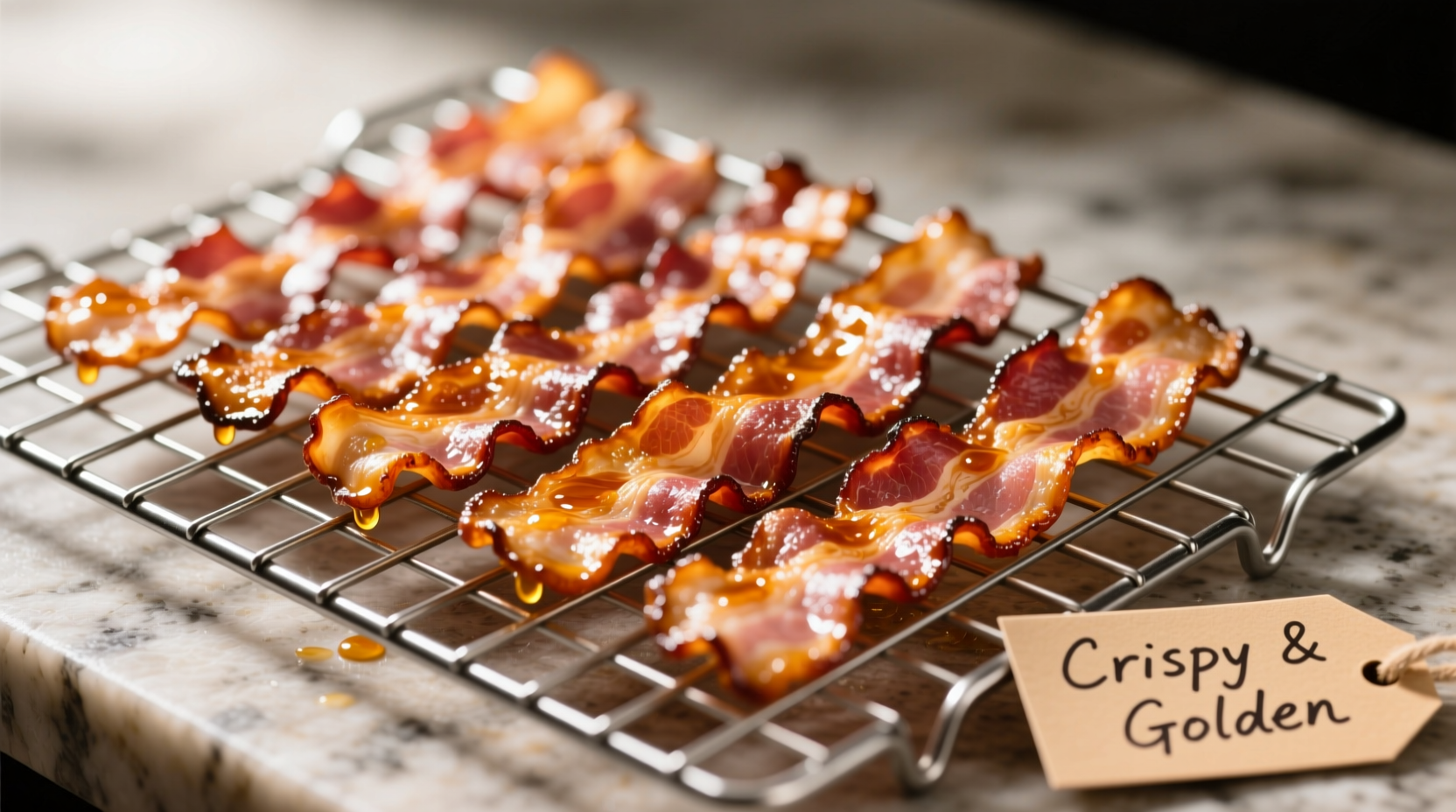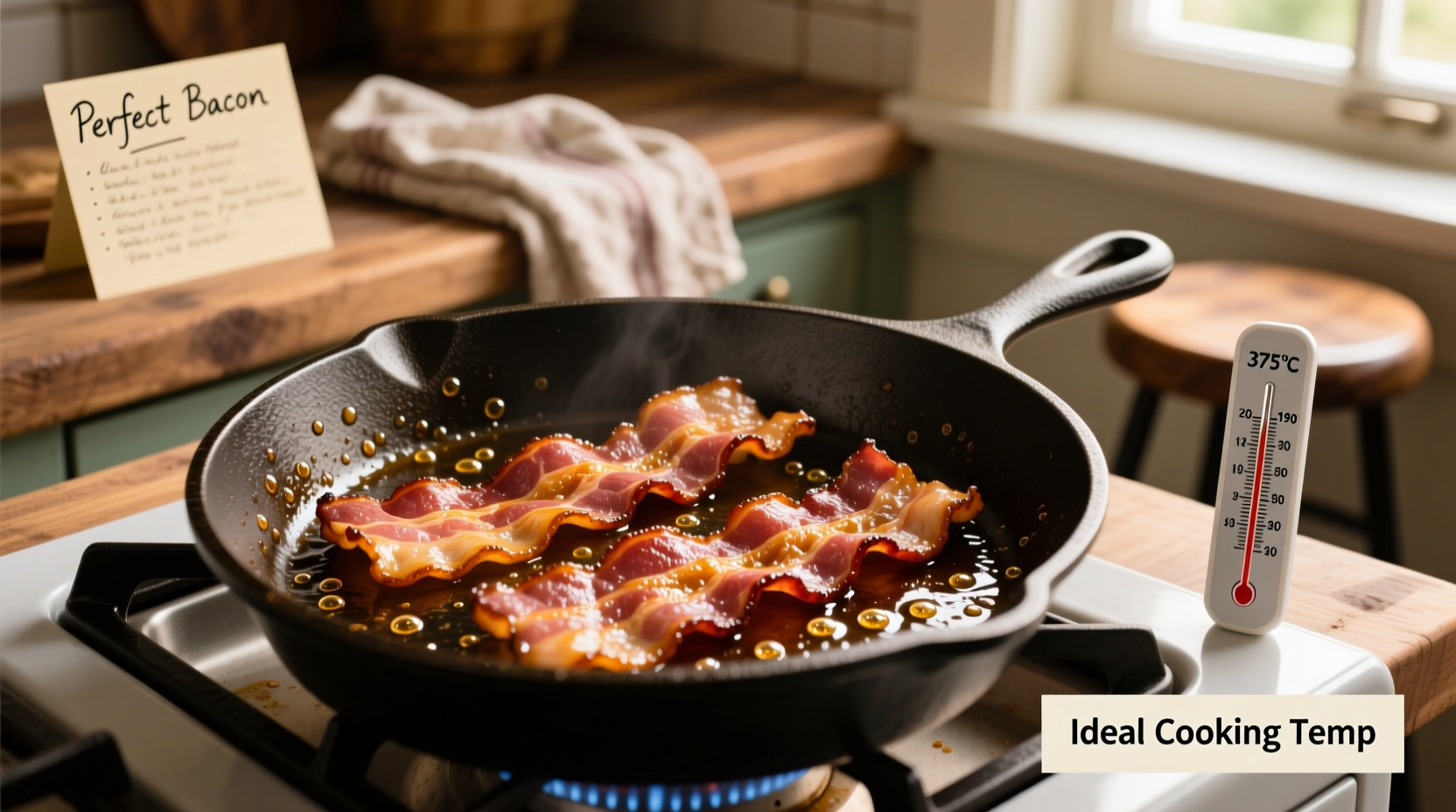The ideal temperature to cook bacon is 375°F to 400°F (190°C to 204°C) in the oven or medium-low heat (approximately 300°F to 325°F / 150°C to 163°C) on the stovetop. For food safety, bacon should reach an internal temperature of at least 145°F (63°C) with a 3-minute rest time, though most chefs recommend 160°F to 165°F (71°C to 74°C) for optimal texture and crispiness.
Getting the temperature right when cooking bacon separates satisfactory results from perfectly crisp, evenly cooked strips every time. Whether you're using an oven, stovetop, or alternative method, understanding the science behind bacon cooking temperatures ensures you achieve that ideal balance of crispy edges and tender meat without burning or undercooking. This guide provides professional techniques backed by food science to help you master bacon preparation regardless of your cooking equipment or skill level.
Why Temperature Control Matters for Perfect Bacon
Bacon's unique composition—a delicate balance of fat and meat—requires precise temperature management. When heated properly, the fat renders slowly, allowing the meat to cook evenly while developing complex flavors through the Maillard reaction. Cooking at too high a temperature causes the fat to splatter violently and the meat to burn before the fat fully renders. Too low, and you'll end up with greasy, undercooked strips that never achieve that satisfying crispness.
Food science reveals that bacon begins rendering fat between 130°F and 140°F (54°C to 60°C), while the Maillard reaction—responsible for that rich, savory flavor—kicks in around 285°F (140°C). The optimal internal temperature for perfectly cooked bacon sits between 160°F and 165°F (71°C to 74°C), where the fat has fully rendered but the meat hasn't become overly dry.
| Cooking Method | Recommended Temperature | Approximate Cooking Time | Internal Temp Target |
|---|---|---|---|
| Oven | 375°F-400°F (190°C-204°C) | 15-25 minutes | 160°F-165°F (71°C-74°C) |
| Stovetop | Medium-low (300°F-325°F / 150°C-163°C) | 8-15 minutes | 160°F-165°F (71°C-74°C) |
| Air Fryer | 350°F-375°F (177°C-190°C) | 10-12 minutes | 160°F-165°F (71°C-74°C) |
| Food Safety Minimum | N/A | N/A | 145°F (63°C) + 3 min rest |
Your Step-by-Step Temperature Guide for Perfect Bacon
Starting Your Cooking Process
Begin with cold equipment regardless of your cooking method. For stovetop cooking, place bacon strips in a cold skillet before turning on the heat. This gradual temperature increase allows the fat to render slowly and evenly. For oven cooking, arrange bacon on a wire rack set over a baking sheet while your oven preheats to ensure consistent temperature from the moment the bacon enters the oven.

Monitoring and Adjusting During Cooking
Temperature control requires active monitoring. On the stovetop, adjust the burner as needed—if bacon sizzles violently with excessive smoke, reduce the heat; if it's not rendering fat after 3-4 minutes, increase slightly. For oven cooking, check at the 10-minute mark and rotate the pan if needed for even cooking. Thicker cuts may require 25-30 minutes at a slightly lower temperature (350°F/177°C).
Knowing When It's Perfectly Done
Visual cues matter as much as temperature. Perfectly cooked bacon should have deep golden-brown edges with the fat fully translucent. Use an instant-read thermometer to verify the internal temperature reaches 160°F-165°F (71°C-74°C). Remember that bacon continues cooking from residual heat after removal, so pull it from heat when it's slightly less done than your preference.
Contextual Factors That Affect Bacon Cooking Temperatures
Several variables influence the ideal temperature for your specific situation:
- Bacon thickness: Thick-cut bacon benefits from slightly lower temperatures (350°F/177°C oven, medium heat stovetop) to allow thorough fat rendering without burning
- Starting temperature: Refrigerated bacon requires slightly longer cooking than room-temperature strips
- Equipment differences: Electric stovetops respond slower to temperature changes than gas
- Desired crispiness: For chewier bacon, remove at 155°F (68°C); for extra-crisp, wait until 165°F (74°C)
The USDA Food Safety and Inspection Service confirms that while 145°F (63°C) with 3-minute rest is the minimum safe temperature for pork products, many culinary professionals prefer higher temperatures for bacon due to its unique fat composition and desired texture. Their guidelines state: "Cook all raw pork steaks, chops, and roasts to a minimum internal temperature of 145°F (63°C) as measured with a food thermometer before removing meat from the heat source." (USDA FSIS)
Troubleshooting Common Temperature Issues
Burning before rendering: Your heat is too high. Start with colder equipment and lower temperatures. For stovetop cooking, begin with the burner at medium-low rather than medium.
Greasy, undercooked bacon: Temperature was too low or cooking time insufficient. Increase heat slightly and allow more time for fat rendering. Thick-cut bacon particularly benefits from longer, slower cooking.
Inconsistent results: Rotate pans in the oven or rearrange strips on the stovetop halfway through cooking. Ovens often have hot spots, and stovetop burners may heat unevenly.
Professional Techniques for Temperature Precision
Restaurant chefs use several advanced techniques to master bacon temperatures:
- The cold start method: Place bacon in a cold skillet, then gradually increase heat to medium-low. This ensures even rendering from the beginning.
- Water method: Add 1/4 inch of water to the skillet with bacon, then cover. As water evaporates (about 8-10 minutes), the bacon finishes crisping in its own rendered fat at controlled temperature.
- Wire rack advantage: When baking, use a wire rack on a baking sheet to allow heat circulation around all sides of the bacon, promoting even cooking.
Food historians note that bacon cooking techniques have evolved significantly. In pre-thermometer eras, cooks relied on visual and auditory cues—the "gentle sizzle" indicated proper rendering temperature. Modern precision tools allow us to achieve consistent results that earlier generations could only approximate through years of experience.
Safety Considerations for Bacon Temperature
While bacon is cured and smoked, it still requires proper cooking to eliminate potential pathogens. The American Egg Board confirms that proper cooking temperatures destroy harmful bacteria that might be present. Though cured meats have reduced risk, following recommended temperature guidelines ensures both safety and optimal texture.
Always use a clean thermometer probe when checking internal temperatures, and sanitize it between uses. Never rely solely on visual cues for food safety, as color alone doesn't guarantee pathogens have been eliminated.











 浙公网安备
33010002000092号
浙公网安备
33010002000092号 浙B2-20120091-4
浙B2-20120091-4